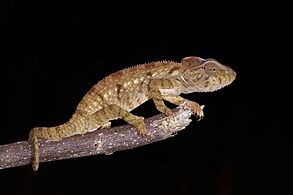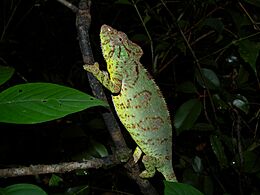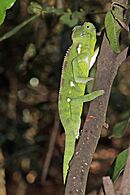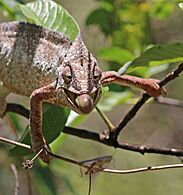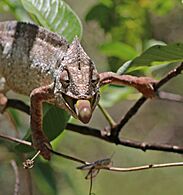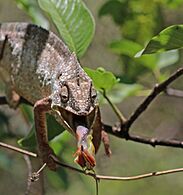Malagasy giant chameleon facts for kids
Quick facts for kids Malagasy giant chameleon |
|
|---|---|
 |
|
| Male, Montagne d’Ambre National Park | |
 |
|
| Female, Anjajavy Forest | |
| Conservation status | |
| Scientific classification | |
| Genus: |
Furcifer
|
| Species: |
oustaleti
|
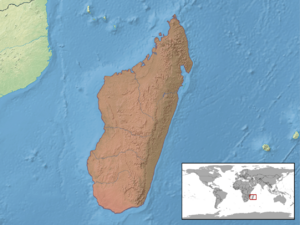 |
|
The Malagasy giant chameleon, also known as Oustalet's chameleon (scientific name: Furcifer oustaleti), is a very large type of chameleon. These amazing reptiles are originally from the island of Madagascar. They have also been found in places like Nairobi, Kenya, and Miami-Dade County in the United States. However, it's not clear how many are still in Kenya. These chameleons can live in many different places, even in villages. They are not often found deep inside thick, untouched forests.
Contents
Where Malagasy Giant Chameleons Live
The Malagasy giant chameleon is found only in Madagascar. This means it is an endemic species to the island. You can find them all over Madagascar.
They live in many different kinds of places. These include dry forests where trees lose their leaves. They also live in wet, green forests and grassy mountain areas. You can even spot them in forests that have been changed by humans. They are also found in farms and even in cities. They usually prefer the edges of forests rather than deep inside them.
What Malagasy Giant Chameleons Look Like
The Malagasy giant chameleon is often called the world's largest chameleon. This is based on its total length, including its tail. It can grow up to about 68.5 centimeters (27 inches) long. Some other chameleons, like Parson's chameleon, might be longer. But this has not been officially proven.
This chameleon is quite slender. Other large chameleons, like Parson's chameleon, can be heavier. Adult male Malagasy giant chameleons usually weigh between 400 and 500 grams (about 1 pound). Females are smaller and weigh less. Females grow up to about 40 centimeters (16 inches) long.
Their head has a tall, helmet-like shape with several ridges. A row of small, triangular spines runs along their back. There are usually 45 or more of these spines.
The colors of these chameleons can change a lot. Males are usually gray or brownish. Sometimes they have reddish-orange feet or bellies. Females have more varied and often brighter colors. They can be red, yellow, or green. Their eyelids can sometimes even be blue!
What Malagasy Giant Chameleons Eat
The Malagasy giant chameleon eats many different things. Their diet includes large insects, which are invertebrates. They also eat small animals with backbones, like tiny birds and other reptiles.
Interestingly, this chameleon is one of the few that also eats fruit. They are known to regularly eat fruits from certain plants. These include Grangeria porosa, Chassalia princei, and Malleastrum gracile. They eat fruit even during the wet season. This suggests they don't just eat fruit for water.
Chameleons usually catch their prey with their long, sticky tongues. But when eating fruit, they often grab it directly with their jaws. Sometimes, they do something very unusual. They have been seen using their special feet to pull fruit-bearing branches closer. Then they eat the fruit. This kind of food handling with their front limbs is rare for reptiles. It's mostly seen in some types of monitor lizards. The Namaqua chameleon is another chameleon known to eat plants.
About Their Name
The scientific name for the Malagasy giant chameleon is Furcifer oustaleti.
The first part of the name, Furcifer, comes from a Latin word. "Furca" means "forked." This refers to the unique shape of the chameleon's feet, which look like they are split or forked.
The second part of the name, oustaleti, is a tribute. It is named after a French biologist named Jean-Frédéric Émile Oustalet. The species was named in his honor.




